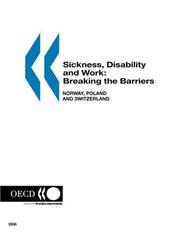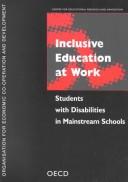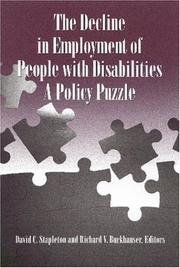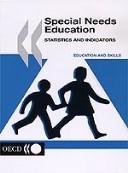| Listing 1 - 10 of 28 | << page >> |
Sort by
|
Book
ISBN: 9780398092429 0398092427 9780398092412 0398092419 Year: 2018 Publisher: Charles C Thomas Publisher
Abstract | Keywords | Export | Availability | Bookmark
 Loading...
Loading...Choose an application
- Reference Manager
- EndNote
- RefWorks (Direct export to RefWorks)
Youth with disabilities --- People with disabilities --- Employment --- E-books --- Handicapped youth --- Physically handicapped youth --- Employment.
Book
ISBN: 9838616974 9789838616973 9789838615280 9838615285 Year: 2015 Publisher: Pulau Pinang, Malaysia : Penerbit Universiti Sains Malaysia,
Abstract | Keywords | Export | Availability | Bookmark
 Loading...
Loading...Choose an application
- Reference Manager
- EndNote
- RefWorks (Direct export to RefWorks)
People with disabilities --- Cripples --- Disabled --- Disabled people --- Disabled persons --- Handicapped --- Handicapped people --- Individuals with disabilities --- People with physical disabilities --- Persons with disabilities --- Physically challenged people --- Physically disabled people --- Physically handicapped --- Persons --- Disabilities --- Sociology of disability --- Employment --- E-books
Book
ISBN: 9001674321 Year: 1984 Publisher: Groningen Wolters-Noordhoff
Abstract | Keywords | Export | Availability | Bookmark
 Loading...
Loading...Choose an application
- Reference Manager
- EndNote
- RefWorks (Direct export to RefWorks)
Orthopedagogics --- Social policy and particular groups --- Netherlands --- Mainstreaming in education --- -Children with disabilities --- -Children with special educational needs --- Children with special health care needs --- Children with special needs --- Handicapped children --- Physically handicapped children --- Special needs children --- Exceptional children --- People with disabilities --- Education --- Inclusive education --- Case studies --- -Mainstreaming in education --- -Case studies --- -Orthopedagogics --- Children with disabilities --- Children with special educational needs --- Education&delete&
Book
ISBN: 1282055631 9786612055638 9264049827 9264049681 Year: 2008 Publisher: Paris : OECD,
Abstract | Keywords | Export | Availability | Bookmark
 Loading...
Loading...Choose an application
- Reference Manager
- EndNote
- RefWorks (Direct export to RefWorks)
Too many workers leave the labour market permanently due to health problems, and yet too many people with a disabling condition are denied the opportunity to work. This third report in the OECD series Sickness, Disability and Work explores the possible factors behind this paradox. It looks specifically at the cases of Denmark, Finland, Ireland and the Netherlands, and highlights the roles of institutions and policies. A range of reform recommendations is put forward to deal with specific challenges facing the four countries.
Chronically ill - Employment -. --- People with disabilities - Employment -. --- Labor & Workers' Economics --- Business & Economics --- People with disabilities --- Chronically ill --- Employment --- Government policy --- Chronic diseases --- Cripples --- Disabled --- Disabled people --- Disabled persons --- Handicapped --- Handicapped people --- Individuals with disabilities --- People with physical disabilities --- Persons with disabilities --- Physically challenged people --- Physically disabled people --- Physically handicapped --- Patients --- Sick --- Persons --- Disabilities --- Sociology of disability --- Denmark --- Finland --- Ireland --- Netherlands

ISBN: 1281737658 9786611737658 9264026320 9264026312 Year: 2006 Publisher: Paris : OECD,
Abstract | Keywords | Export | Availability | Bookmark
 Loading...
Loading...Choose an application
- Reference Manager
- EndNote
- RefWorks (Direct export to RefWorks)
Why is it that health is improving, yet more and more people of working age end up out of the workforce relying on long-term sickness and disability benefits? This first report in a new OECD series on sickness, disability and work explores the possible factors behind this paradox. It looks specifically at the cases of Norway, Poland and Switzerland, and highlights the role of institutions and policies. A range of reform recommendations is put forward.
Chronically ill. --- People with disabilities. --- Business & Economics --- Labor & Workers' Economics --- People with disabilities --- Chronically ill --- Employment --- Government policy --- Chronic diseases --- Cripples --- Disabled --- Disabled people --- Disabled persons --- Handicapped --- Handicapped people --- Individuals with disabilities --- People with physical disabilities --- Persons with disabilities --- Physically challenged people --- Physically disabled people --- Physically handicapped --- Patients --- Sick --- Persons --- Disabilities --- Sociology of disability --- Norway --- Poland --- Switzerland

ISBN: 1280081333 9786610081332 9264180389 9264171215 Year: 1999 Publisher: Paris, France : Organisation for Economic Co-operation and Development,
Abstract | Keywords | Export | Availability | Bookmark
 Loading...
Loading...Choose an application
- Reference Manager
- EndNote
- RefWorks (Direct export to RefWorks)
The rights of students with disabilities to be educated in their local mainstream school is becoming more and more accepted in most countries, and many reforms are being put in place to achieve this goal. Further, there is no reason to segregate disabled students in public education systems; instead, education systems need to be reconsidered to meet the needs of all students. Based on in-depth analysis of inclusive practice in eight countries, this book addresses the issues that arise for such practices to be successful. The most detailed international comparative study ever carried out, this book shows that all students, whatever the type and extent of their disability, can be successfully included in mainstream schools, as long as certain safeguards are ensured. Nine areas emerge as being of crucial importance: funding models, systems of public accountability for schools, pupil assessment, curriculum development, adult-to-student ratios, the role of classroom assistants, the functioning of support services, the training of teachers and other professionals and community and parental involvement. The country case studies are complemented by comprehensive annexes describing how teachers can be most efficiently prepared for special education, and developing a procedure for cost-effectiveness analysis of special education.
Social Issues/Migration/Health --- Education --- Mainstreaming in education --- Children with disabilities --- Education and state --- Social Sciences --- Education, Special Topics --- Children with special educational needs --- Children with special health care needs --- Children with special needs --- Handicapped children --- Physically handicapped children --- Special needs children --- Exceptional children --- People with disabilities --- Inclusive education

ISBN: 0880992603 0585473668 9780585473666 088099259X 9780880992596 9780880992602 Year: 2003 Publisher: Kalamazoo : W. E. Upjohn Institute for Employment Research,
Abstract | Keywords | Export | Availability | Bookmark
 Loading...
Loading...Choose an application
- Reference Manager
- EndNote
- RefWorks (Direct export to RefWorks)
People with disabilities -- Employment -- Government policy -- United States. --- People with disabilities -- Employment -- United States -- Statistics. --- People with disabilities -- Employment -- United States. --- People with disabilities --- Employment --- Government policy --- E-books --- Cripples --- Disabled --- Disabled people --- Disabled persons --- Handicapped --- Handicapped people --- Individuals with disabilities --- People with physical disabilities --- Persons with disabilities --- Physically challenged people --- Physically disabled people --- Physically handicapped --- Persons --- Disabilities --- Sociology of disability
Book
ISBN: 922120152X 9221201538 9789221201533 Year: 2007 Publisher: Geneva : International Labour Office,
Abstract | Keywords | Export | Availability | Bookmark
 Loading...
Loading...Choose an application
- Reference Manager
- EndNote
- RefWorks (Direct export to RefWorks)
This guide highlights basic knowledge from the fields of labour and disability statistics which has to be combined for a comprehensive description of the employment situation of people with disabilities. It will be of great relevance to worldwide countries as they work to promote and monitor equal employment opportunities for disabled persons.
People with disabilities -- Employment. --- People with disabilities -- Vocational guidance. --- Business & Economics --- Labor & Workers' Economics --- People with disabilities --- Employment --- Research. --- Methodology. --- Cripples --- Disabled --- Disabled people --- Disabled persons --- Handicapped --- Handicapped people --- Individuals with disabilities --- People with physical disabilities --- Persons with disabilities --- Physically challenged people --- Physically disabled people --- Physically handicapped --- Persons --- Disabilities --- Sociology of disability --- Employment&delete& --- Statistical methods --- Research --- Methodology --- E-books

ISBN: 1280030771 9786610030774 926418810X 9264176896 Year: 2000 Publisher: Paris : OECD Publishing,
Abstract | Keywords | Export | Availability | Bookmark
 Loading...
Loading...Choose an application
- Reference Manager
- EndNote
- RefWorks (Direct export to RefWorks)
This book provides a full account of a totally new approach to making international comparisons in the field of special needs education. It makes comparisons of students with disabilities, learning or behaviour difficulties and disadvantages on the basis of the additional resources made available to them to access the curriculum, which in some countries covers some 35% of school-age students. To improve the quality of the comparisons made countries re-classified their own classification schemes and data into a new tri-partite cross-national classification system:-Category A covers those students whose disabilities have clear biological causes.-Category B covers those students who are experiencing learning and behaviour difficulties for no particular reason. -Category C covers those students who have difficulties arising from disadvantages.Among the many analyses provided, the book highlights the numbers of students involved, where they are educated (special schools, special classes and regular schools), and a breakdown by gender. Data has been provided by 23 countries: Austria, Belgium (Flemish Community), Canada (New Brunswick), the Czech Republic, Denmark, Finland, France, Germany, Greece, Hungary, Ireland, Italy, Korea, Mexico, the Netherlands, New Zealand, Portugal, Spain, Sweden, Switzerland, Turkey, the United Kingdom and the United States.
Learning disabled children -- Education. --- Special education - Statistics. --- Special education. --- Children with disabilities --- Education --- Children with special educational needs --- Children with special health care needs --- Children with special needs --- Handicapped children --- Physically handicapped children --- Special needs children --- Exceptional children --- People with disabilities
Book
ISBN: 1441612688 9781441612687 9780880994408 0880994401 9780880993463 0880993464 9780880993470 0880993472 Year: 2009 Publisher: Kalamazoo, Michigan : W.E. Upjohn Institute for Employment Research,
Abstract | Keywords | Export | Availability | Bookmark
 Loading...
Loading...Choose an application
- Reference Manager
- EndNote
- RefWorks (Direct export to RefWorks)
U.S. government agencies compile a thorough set of statistics on populations defined by age, race, ethnicity, and marital status-but not by disability status. Therefore, working-age people with disabilities are often overlooked in discussions of the latest statistics on employment, income, poverty, and other measures of the status of a particular population. This book helps remedy this situation by providing a systematic review of what current statistics and data on working-age people with disabilities can and cannot tell us, and how the quality of the data can be improved to better inform policymakers, advocates, analysts, service providers, administrators, and others interested in this at-risk population.
People with disabilities --- Cripples --- Disabled --- Disabled people --- Disabled persons --- Handicapped --- Handicapped people --- Individuals with disabilities --- People with physical disabilities --- Persons with disabilities --- Physically challenged people --- Physically disabled people --- Physically handicapped --- Persons --- Disabilities --- Sociology of disability --- Employment --- Social conditions --- E-books --- Social conditions. --- Employment. --- Supported employment
| Listing 1 - 10 of 28 | << page >> |
Sort by
|

 Search
Search Feedback
Feedback About UniCat
About UniCat  Help
Help News
News